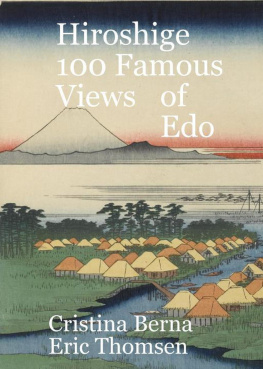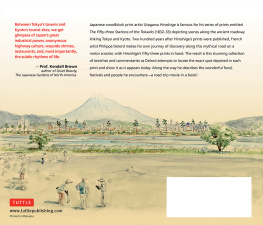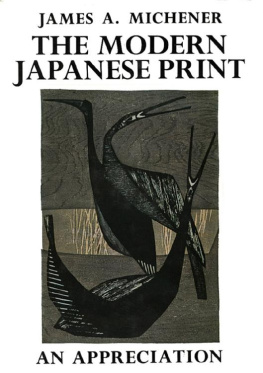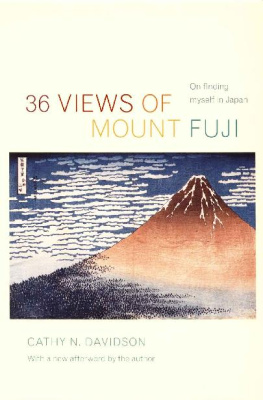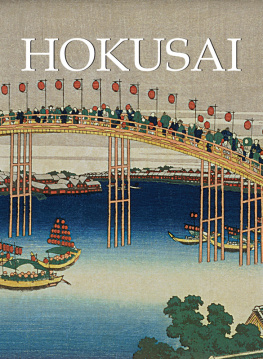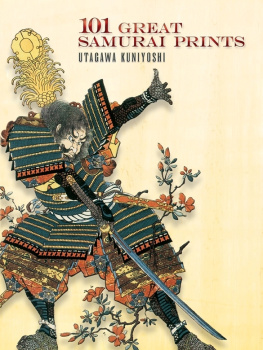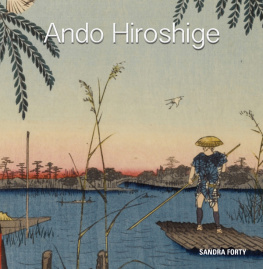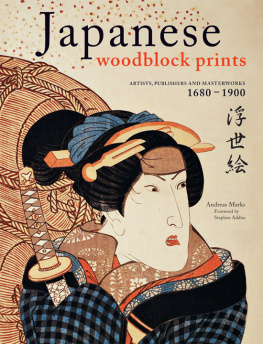Copyright
Copyright 2013 by Dover Publications, Inc.
All rights reserved.
Bibliographical Note
This Dover edition, first published in 2013, is an a unabridged republication of One Hundred Views of Mt. Fuji, originally published by Frederick Publications, New York, 1960, and all the plates from The Thirty-Six Views of Mt. Fuji, originally published by Takamizawa Ukiyoe Co., Ltd., Tokyo, n.d. The Introduction to Thirty-Six Views of Mt. Fuji, found on pages 241250, was reprinted from Hokusais 36 Views of Mt. Fuji, originally published by Toto Shuppan Company, Ltd., Tokyo, 1959.
Library of Congress Cataloging-in-Publication Data
Katsushika, Hokusai, 1760-1849.
[Prints. Selections]
Views of Mt. Fuji / Katsushika Hokusai.
p. cm.
Summary: Kasushika Hokusai was one of the foremost ukiyo-e artists of his generation and his Thirty-six Views of Mt. Fuji one the best know series in all of Japanese woodblock printing. Mt. Fuji had and continues to have a mythical hold on the Japanese imagination, and Hokusai depicts the endless depth and variety the mountain conveys through its situation in landscape, season, and time of day. This Dover book reprints the Thirty-six Views of Mount Fuji series in color along with Hokusais later black & white series, One Hundred Views of Mount Fuji. A must for all lovers of Japanese art and the woodblock prints of the floating worldProvided by publisher.
This Dover edition, first published in 2013, is an a unabridged republication of One Hundred Views of Mt. Fuji, originally published by Frederick Publications, New York, 1960, and all the plates from The Thirty-Six Views of Mt. Fuji, originally published by Takamizawa Ukiyoe Co., Ltd., Tokyo, n.d. The Introduction to Thirty-Six Views of Mt. Fuji found on pages 241-250, was reprinted from Hokusais 36 Views of Mt. Fuji, originally published by Toto Shuppan Company, Ltd., Tokyo, 1959.
eISBN-13: 978-0-486-31599-7
ISBN-10: 0-486-49758-5
1. Katsushika, Hokusai, 1760-1849. Thirty-six views of Mt. Fuji. 2. Katsushika, Hokusai, 1760-1849. Hundred views of Mount Fuji. 3. Fuji, Mount (Japan)In art. I. Title.
NE1325.K3A4 2013
769.92dc23
2013015606
Manufactured in the United States by Courier Corporation
497585012013
www.doverpublications.com
DESCRIPTION OF FUJISAN.
(From the 56th Volume of the Wa-kan-sanzai-dzuye.)
T O the South the Mountain looks towards the province of Suruga, Eastwards over the province of Sagami, to the North and West over that of Kai, to the North and East in the direction of Idsu. The fame of it is unequalled throughout the three realms (Japan, China, and India). Viewed from any of the surrounding eight provinces it presents the same appearance, its summit reminding the beholder of the eightpetaled renge (lotus flower, commonly known in Japan as hachisu-bana, or hasu-nohanaNelumbo nucifera Gaert). But viewed from front the peak is seen to be trifid. If you want to have an exact notion of the form of the Mountain, take a ten-ribbed fan, roll this conewise, and draw out one rib, so as to leave nine remaining, then place the fan with the truncated apex upwards, and you have the Mountain before you. I should here remark that from Hakone the peak looks five-pointed, from Hara four-pointed, from Yejiri trifid.
Tradition tells us that the manifestation of Fuji took place in the fifth year of the reign of the Emperor Krei (B.C. 285). In one night it was formed. The earth gaped in the province of mi, and Lake Biwa or mi was thus produced, the soil thrown up becoming the Mountain in Suruga. [The histories, however, say nothing about this event, and in my opinionthat of the author of the Sanzaithe whole story is little worthy of belief.]
Throughout the four seasons snow lies upon Fuji; from the hollow summit smoke constantly issues. In shape Mikami-yama in mi is like to it, but is on a smaller scale, as if indeed it had been made by the hand of man.
Jofuku (S Fuh) of Shin in China is said to have discovered a mountain in the reign of the Emperor Krei, which was Fujisan. Afterwards, Yen no Shkaku was the first to open up the Mountain to men. [Although the Mountain is said to be situate in Suruga, the tori-i of the principal approach is on the Northern slope in the province of Kai.]
The first shrine on the Mountain was erected by the Emperor Heij, or Heizei, in the first year of the period Daid (A.D. 806). Every year from the sixth month (July-August), crowds of pilgrims make the ascent, having first refrained from fish and flesh, and used ablutions for a hundred days. The people of the province of mi, however, need only fast for seven days, the reason of this privilege being the fact that the mass of Fuji consists of the soil of that province, from old time a favourite abode of the gods. The slopes of the Mountain are covered with loose stones, which roll down under the feet of the pilgrims during the day, but slip up again in the night-time, so that the Mountain remains unchanged in size and form. Keyaki trees (a kind of elm, Zelkowa Keyaki) are plentiful on Fuji.
Fuji no iie ni
furi-tsumoru yuki wa,
minadzuki no,
nochi ni kiyete wa ;
sono yo furitsutsu. | On the Peak of Fuji
falls the snow in heaps,
past the godless month,
vanishes the snow away,
and the same night falls again. |
Yoshika of the Capital tells us in his Chronicles that Fuji is situate in Suruga, and forms a truncated cone, rising high into the sky, of immeasurable loftiness, the like of which is not to be found described in any book. The exalted peak seems to touch Heaven: for the broad and deep foundations we must search the abysses of the ocean. Many days are needed to travel round it, and learn all its beauty and splendour. So huge is Fujisan that the receding traveller, as he looks back upon it from time to time, imagines that he is still in the near neighbourhood of the Great Mountain, which genii have made their haunt.
Arne tsuchi no
wakareshi toki ni,
kami sabite,
takaku ttoki
Suruga naru
Fuji no takane wo !
A ma no hara
furisake mireba,
wataru hi no
kage mo kakuroi,
teru tsuki no
hiikari mo miyedzu,
shira-kumo mo
i-yuki habakari,
tokijiku zo
yuki wa furikeru,
katari-tsugi,
iitsugi yukan,
Fuji no takane wa ! | Heaven above from earth below
when of yore the god did part,
lonely in his majesty,
Fuji loftily sublime,
oer Surugas land uprose!
O the towring peak of Fuji!
All the vasty plain of heaven,
when with upturnd glance men scan it,
and of sun on daily path
all the lustrous light is hidden,
and of nightly radiant moon
not a shimmer may be seen,
still round thee shall white clouds hover,
scarcely daring stay or go;
still the snow shall fall upon thee,
ever falling ceaselessly;
still shall men the story tell,
ever men the tale shall tell,
lofty peak of Fujisan! |
In the Six Sections of Gisho (a Chinese miscellany) we read: There is a Mountain to the east-north of the capital of Japan, some thousand li away, which people call Fuji, also Hrai. It is very steep, three sides thereof rising sheer out of the sea, and flames and smoke are belched forth from its lofty summit. At noontide various treasures are manifested to the climber under his-feet; after nightfall music may be heard on the Mountain. Here came of old Jofuku, and gave to the Mountain the name Horai. To the descendants of this sage it has been permitted to use the surname Hata.
When Hideyoshi (Taiksama) overran Chsen (Korea), one of his warriors, by name Kat Kiyomasa, took prisoner in Orankai (a district of Korea) a man named Serutosu, a Japanese of Matsumaye in Yezo, who some twenty years previously had been cast by a storm upon the Korean coast. On being brought back by his capturer to his own country, he assumed the name of Gotjir. According to his statements Fuji was as visible from the Korean shores on a clear day as if it were in close neighbourhood to them.
Next page
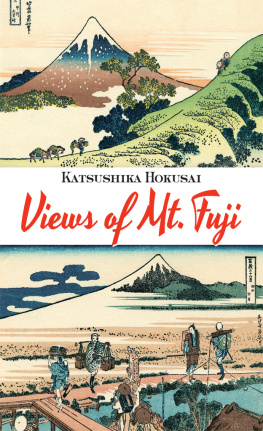
![Roger Zelazny - 24 Views of Mt. Fuji, by Hokusai [Illustrated]](/uploads/posts/book/536181/thumbs/roger-zelazny-24-views-of-mt-fuji-by-hokusai.jpg)


